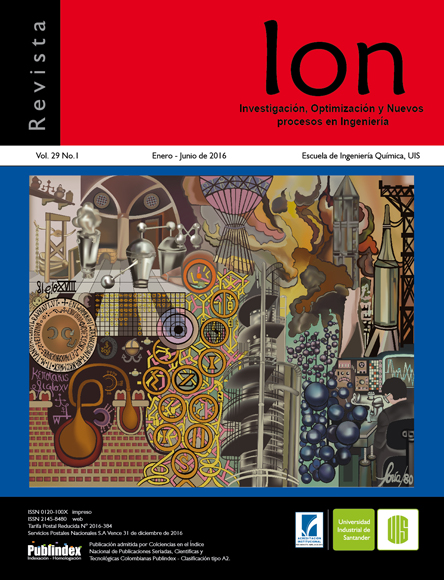Avaliação do co-digestão anaeróbia de lodo de esgotos locais com resíduos dos alimentos
Publicado 2016-07-15
Palavras-chave
- Co-digestão,
- Produção de Metano,
- Lodo Primária,
- Lodos Secundário Espessadas,
- Resíduos de Alimentos.
Como Citar
Resumo
A digestão anaeróbia é um processo muito utilizado para o tratamento dos lodos produzidos em estações de tratamento de esgoto, devido às suas vantagens técnicas e econômicas. Este artigo apresenta um estudo em que o co-digestão de lodo de esgotos com resíduos de alimentos (RA) foi avaliado como uma estratégia para otimizar a digestão dos lodos. Foram realizados mono-digestão e co-digestão dos substratos em condições mesoflicas (35°C) utilizando reactores descontínuos. Os lodos utilizado foram: lodo primária (LP), lodos secundário espessadas (LSE) e uma mistura de LP com LSE em 60:40 à base de sólidos totais (LP:LSE). As co-digestões foram realizadas utilizando diferentes proporções de misturas de substratos à base de sólidos totais voláteis: LP:RA=30:70, LP:RA=50:50, LP:RA=70:30 (LP+LSE):RA=70:30. A máxima produção de metano, 0,25LCH4/gSVadicionado, foi obtido por mistura de LP:RA=30:70, apresentando uma produção 32% maior que a obtida no mono-digestão de lodo primário.
Downloads
Referências
[2] Rao PV, Baral SS. Experimental design of mixture for the anaerobic co-digestion of sewage sludge. Chem Eng J. 2011;172(1-2):977-86.
[3] Arnaiz C, Gutierrez JC, Lebrato J. Biomass stabilization in the anaerobic digestion of wastewater sludges. Bioresour. Technol. 2006;97(10):1179-84.
[4] Nathan DP, Ronald WT, Steve SH. Comparison of methane production by co-digesting fruit and vegetable waste with first stage and second stage anaerobic digester sludge from a two stage digester. Water Sci. Technol. 2012;65(7):1252–7.
[5] Kim J, Kang C-M. Increased anaerobic production of methane by co-digestion of sludge with microalgal biomass and food waste leachate. Bioresour. Technol. 2015;189:409-12.
[6] Cesaro A, Naddeo V, Amodio V, Belgiorno V. Enhanced biogas production from anaerobic codigestion of solid waste by sonolysis. Ultrason Sonochem. 2012;19(3):596-600.
[7] Gómez X, Cuetos MJ, Cara J, Morán A, García AI. Anaerobic co-digestion of primary sludge and the fruit and vegetable fraction of the municipal solid wastes: Conditions for mixing and evaluation of the organic loading rate. Renew Energy. 2006;31(12):2017-24.
[8] Bond T, Brouckaert CJ, Foxon KM, Buckley CA. A critical review of experimental and predicted methane generation from anaerobic codigestion. Water Sci Technol. IWA Publishing. 2012;65(1):183-9.
[9] Lin J, Zuo J, Gan L, Li P, Liu F, Wang K, et al. Effects of mixture ratio on anaerobic co-digestion with fruit and vegetable waste and food waste of China. J Environ Sci. 2011;23(8):1403-8.
[10] Cabbai V, Ballico M, Aneggi E, Goi D. BMP tests of source selected OFMSW to evaluate anaerobic codigestion with sewage sludge. Waste Manag. 2013;33(7):1626-32.
[11] Iacovidou E, Ohandja D-G, Voulvoulis N. Food waste co-digestion with sewage sludge – Realising its potential in the UK. J Environ Manage. 2012;112:267-74.
[12] Huang W, Huang W, Yuan T, Zhao Z, Cai W, Zhang Z, et al. Volatile fatty acids (VFAs) production from swine manure through short-term dry anaerobic digestion and its separation from nitrogen and phosphorus resources in the digestate. Water Res. 2016;90:344-53.
[13] Zeng Y, De Guardia A, Dabert P. Improving composting as a post-treatment of anaerobic digestate. Bioresour. Technol. 2016;201:293-303.
[14] Zeshan, Visvanathan C. Evaluation of anaerobic digestate for greenhouse gas emissions at various stages of its management. Int Biodeterior Biodegradation. 2014;95(A):167-75.
[15] Angelidaki I, Alves M, Bolzonella D, Borzacconi L, Campos JL, Guwy AJ, et al. Defining the biomethane potential (BMP) of solid organic wastes and energy crops: a proposed protocol for batch assays. Water Sci Technol. 2009;59(5):927-34.
[16] Ponsá S, Gea T, Sánchez A. Anaerobic co-digestion of the organic fraction of municipal solid waste with several pure organic co-substrates. Biosyst Eng. 2011;108(4):352-60.
[17] APHA. Standard Methods for Examination of Water and Wastewater. 22nd ed. New York: American Public Health Association; 2012.
[18] Instituto Colombiano de Normas Técnicas NTC 5167. Productos para la industria agrícola. Productos orgánicos usados como abonos o fertilizantes y enmiendas de suelo. Bogotá, Colombia; 2004.
[19] Jenkins SR, Morgan JM, Sawyer CL. Measuring anaerobic sludge digestion and growth by a simple alkalimetric titration. Water Pollut Control Fed. 1983;55(5):448–53.
[20] Ripley LE, Boyle WC, Converse JC. Improved alkalimetric monitoring for anaerobic digestion of high strength wastes. Water Pollut Control Fed. 1986;58(5):406–11.
[21] Jain S, Jain S, Wolf IT, Lee J, Tong YW. A comprehensive review on operating parameters and different pretreatment methodologies for anaerobic digestion of municipal solid waste. Renew Sustain Energy Rev. 2015;52:142-54.
[22] Sosnowski P, Wieczorek A, Ledakowicz S. Anaerobic co-digestion of sewage sludge and organic fraction of municipal solid wastes. Adv Environ Res. 2003;7(3):609-16.
[23] Koch K, Plabst M, Schmidt A, Helmreich B, Drewes JE. Co-digestion of food waste in a municipal wastewater treatment plant: Comparison of batch tests and full-scale experiences. Waste Manag. 2016;47(A):28-33.
[24] Marañón E, Castrillón L, Quiroga G, Fernández-Nava Y, Gómez L, García MM. Co-digestion of cattle manure with food waste and sludge to increase biogas production. Waste Management.2012;32(10):1821-5.
[25] Siddiqui Z, Horan NJ, Anaman K. Optimisation of C:N Ratio for Co-Digested Processed Industrial FoodWaste and Sewage Sludge Using the BMP Test. Int J Chem React Eng. 2011;9(1):1-12.

